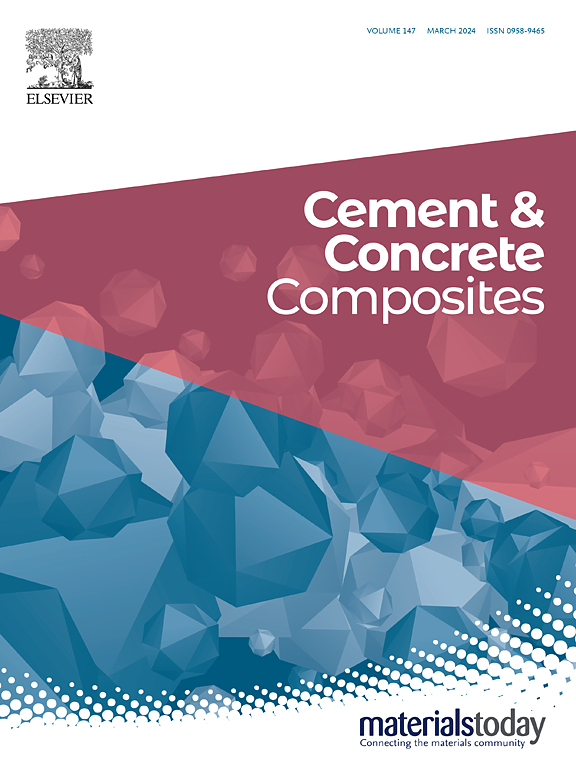新型纤维取向法铸造纤维增强胶凝复合材料断裂性能研究
IF 10.8
1区 工程技术
Q1 CONSTRUCTION & BUILDING TECHNOLOGY
引用次数: 0
摘要
当纤维均匀分散并平行于主应力方向排列时,纤维增强胶凝复合材料(FRCC)的力学性能得到增强。本文介绍了一种新型的纤维球振动方法来改善纤维在FRCC中的取向。评价了用该方法制备的FRCC的断裂性能,分析了纤维在基体中的分布与纤维取向因子和断裂性能的关系。此外,对纤维球与膏体之间的界面过渡区(ITZ)进行了表征,揭示了纤维球振动法影响FRCC断裂性能的机理。实验结果表明,纤维-球振动法使纤维更有效地排列,使纤维沿主应力方向的取向因子比常规混合技术提高了62.5%。该方法制备的FRCC具有较好的断裂性能,其初始裂纹韧性比普通水泥砂浆提高了26.2%,比采用常规搅拌方法制备的FRCC提高了29.8%。此外,与普通水泥砂浆相比,不稳定断裂韧性和断裂能分别提高了40%和470%,尽管这些增强效果仍低于常规搅拌。这种差异主要是由于纤维团簇和钢球表面光滑的负面影响,增加了FRCC内部区域的内部脆弱性,导致纤维球与浆料之间的ITZ更宽,弹性模量更低。然而,纤维球振动法为纤维定向提供了一种很有前途的方法。进一步细化后,通过优化纤维沿主应力方向的分布,可以获得更大的增韧效果。本文章由计算机程序翻译,如有差异,请以英文原文为准。
Investigation of fracture property of the fiber-reinforced cementitious composites casted using a novel fiber orientation method
Fiber-reinforced cementitious composites (FRCC) exhibit enhanced mechanical properties when fibers are uniformly dispersed and aligned parallel to the principal stress direction. This study introduces a novel fiber-ball vibration method to improve fiber orientation in FRCC. The fracture performance of FRCC prepared with this method was evaluated, and the fiber distribution within the matrix was analyzed in relation to the fiber orientation factor and fracture performance. Additionally, the interfacial transition zone (ITZ) between the fiber-balls and the paste was characterized, revealing the mechanisms through which the fiber-ball vibration method influences FRCC fracture performance. Experimental results indicate that the fiber-ball vibration method causes fibers to align more effectively, resulting in a 62.5 % increase in the fiber orientation factor along the principal stress direction compared to conventional mixing techniques. FRCC produced by this method demonstrates enhanced fracture performance, with a 26.2 % increase in initial crack toughness over plain cement mortar and a 29.8 % increase over FRCC fabricated using the conventional mixing method. Furthermore, unstable fracture toughness and fracture energy increased by 40 % and 470 %, respectively, compared to plain cement mortar, although these enhancements remained lower than those achieved with conventional mixing. The disparity is primarily attributed to the wider ITZ and lower elastic modulus between fiber-balls and paste, stemming from the negative effects of clustering of fibers and the smooth surface of steel balls, which increase the internal vulnerability in internal regions of FRCC. Nevertheless, the fiber-ball vibration method offers a promising approach for orienting fibers in FRCC. With further refinement, this method could achieve even greater toughening effects by optimizing the distribution of fibers along the principal stress direction.
求助全文
通过发布文献求助,成功后即可免费获取论文全文。
去求助
来源期刊

Cement & concrete composites
工程技术-材料科学:复合
CiteScore
18.70
自引率
11.40%
发文量
459
审稿时长
65 days
期刊介绍:
Cement & concrete composites focuses on advancements in cement-concrete composite technology and the production, use, and performance of cement-based construction materials. It covers a wide range of materials, including fiber-reinforced composites, polymer composites, ferrocement, and those incorporating special aggregates or waste materials. Major themes include microstructure, material properties, testing, durability, mechanics, modeling, design, fabrication, and practical applications. The journal welcomes papers on structural behavior, field studies, repair and maintenance, serviceability, and sustainability. It aims to enhance understanding, provide a platform for unconventional materials, promote low-cost energy-saving materials, and bridge the gap between materials science, engineering, and construction. Special issues on emerging topics are also published to encourage collaboration between materials scientists, engineers, designers, and fabricators.
 求助内容:
求助内容: 应助结果提醒方式:
应助结果提醒方式:


